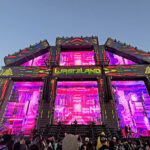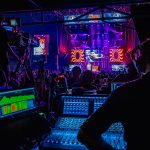Words cannot quite capture the visual extravaganza that is Miami Ultra Music Festival (UMF) 2016. Now in its 18th year, the hugely popular electronic dance music (EDM) event held annually on Bayfront in downtown Miami, played host to a sellout crowd of more than 165,000 over three days, from March 24-26. The event’s Main Stage, Carl Cox & Friends Stage and World Wide Stage would each be, by themselves, impressive enough to anchor a major music festival. Combined and extended by other stages, including the U.S. debut of the flame-shooting Arcadia Spider on the Resistance Stage, the Ultra Music Festival retains its perch as a world-class blockbuster event.

The Main Stage
The main stage, provided by Mountain Productions, measured about 210 feet in width and more than 80 feet in height, housing an 80-by-70-foot performance area. Along with a 40-foot turntable, the main stage was flanked by wings that were 40 feet wide.
Steve Lieberman of SJ Lighting collaborated with creative director Richard Millstein, production manager Ray Steinman and LD Patrick Dierson along with SJ Lighting’s Josh Spodick on the Main Stage’s structural and visual design.

The Main Stage hosted top EDM acts (and guest LDs) including Hardwell (Andre Beekmans), Pendulum (Andy Hurst), David Guetta (Sam MacClaren, lighting director for Jonathan “Leggy” Armstrong), Fedde Le Grande (JJ Rotte), Avicii (Chris van Bokhorst), Afrojack (Bas Scheij) and Tiesto (Aron Altmark), among others.
Solotech provided the lighting fixtures for the Main Stage, including 280 Elation Elar 108 LED Pars, 192 Chroma-Q Color Force 72s, 216 Martin Atomic 3000 strobes, 192 Chromlech Jarag Lines, 122 Clay Paky Sharpys, 104 Philips Color Kinetics ColorBlast 12s, 48 Krypton KR-10s, 30 MagicBlade R fixtures and eight MDG The One foggers/hazers. Solotech also provided three grandMA full-size consoles for control.

In terms of video, the Main Stage featured screen tiles supplied by Screenworks including 223 panels of the company’s own tiles and Magic Cube (MC) panels from ROE Creative Display. The latter included MC-12 (12mm, 640 panels), MC7 Black (7mm, 420 panels), Linx 9mm (132 panels) and 174 panels for Digiled M15 sub-rented from Pete’s Big TVs.
The Main Stage’s 2,000 feet of screen tiles were processed by five 1080p rasters pixel-mapped via 32×32 DVI matrix, notes Randy Mayer, director of concert touring for Screenworks. Accommodating seven simultaneous inputs from several VJs, the FOH package controlled house servers provided by VSquared Labs.
VSquared’s Vello Virkhaus served as visuals director and Nick O’Bryen, project manager for Screenworks, oversaw the onsite installation. The Screenworks crew included Ritesh Patel, Karl Naval, Billy Stewart, Denny Relf, John Richmond, Spencer King, Jeff Smith and Chris Small.

Carl Cox and World Wide Stages
The Carl Cox & Friends Stage arched roof structure, supplied by AG Production Services, is enclosed on three sides and measures 155 60 by 200 feet (WxHxL). Turned sideways, the same roofing system covers the Ultra World Wide stage, allowing for open-air sides. Also owned by AG, it measures 180 feet wide at the base and 72 feet high from the center point.

This year, the Carl Cox & Friends Stage incorporated a wide selection of lighting fixtures, including 24 Robe BMFL Spots, 96 Robe Pointes, 52 Martin MAC Vipers, 111 Elation Color Chorus 72s and 236 Elation Opti Tri 30 LED pars. AG and Zenith Lighting provided the fixtures.
Fifty-six XLNT CyberHoist motors provide automation to lift and move eight truss and video pods located over the Carl Cox audience, tilting, pitching and dramatically changing the feel of the venue. Each of the pods is loaded with 37mm video panels and Elation Opti Tri 30 pars.

The Carl Cox upstage wall featured additional 8mm video panels from AG, with signal processed by an Analog Way Ascender 48. This provided consistent video signal and sizing due to the various media servers provided by the numerous DJ’s and their crew.
Lieberman used the grandMA2 to control the 31 DMX universes necessary for the Carl Cox Stage. “I have been using the grandMA ever since its launch and have never looked back,” he says. “It offers fast programming and a level of control that thinks the way I do. When you have a massive fixture count like we do in the Carl Cox Stage, the grandMA takes it all in and never misses a beat drop.

“On the World Wide Stage, we used the Chauvet NXT1,” Lieberman adds. “That is a pretty cool fixture. It has tight beams with pixel mapping and is very fast.” The rig also featured 56 Martin MAC 101’s, 52 Clay Paky Sharpys and 33 Elation Platinum Profile 35 Pros. Once again, MA Lighting’s grandMA2 served as the platform controlling more than 26 universes of DMX.
AG provided the World Wide Stage with 223 8mm video panels to deliver custom content and graphics for each of the DJ’s. “Video plays a large part in any EDM festival,” says AG’s Andrew Gumper. “Combining video with lighting has a powerful impact on defining the setting and offers unlimited looks and effects for all of the DJ’s appearing throughout the three-day festival.”

The Triumvirate
The UMF’s crowds, culture and technology today embrace quite a different picture from the early years. In 2007, the festival was on the brink of success or failure. The owners brought Ray Steinman on board full-time as producer and production manager. Steinman, a 30-year veteran of rock ‘n’ roll touring, also spent many years at the helm as Gloria Estefan’s tour manager.
“The owners allowed me to do what I needed to do, replacing and bringing in new venders.” Thus began his enduring association with SJ Lighting, AG Production Services and Mountain Productions.
Steinman jokes that he began in the concert business “before there were fax machines.” As far as transitioning to his position with UMF, Ray recalls that, “It kind of happened organically. Ultra is right here in my backyard, and there are certain elements in country, EDM, rock, jazz, that are the same. For a production guy like me, it is a lot of fun to work in on such an enormous platform in this space with all these huge elements.”
The triumvirate of Ray Steinman, Steve Lieberman (SJ) and Andrew Gumper (AG) has worked closely over many years to produce, design and create the iconic look that is UMF. Steinman points out that Lieberman is the creative mind behind the massive arched roof, which Gumper owns.

A Futuristic Vibe
When speaking with the principals producing and designing the event, they refer to environments and moments as to what drives the elements that create UMF.
Says Lieberman, “Ultra is a very futuristic-style production environment. That, by itself, gives us a start to our creative process. I like to think of it as a sharp edge to the design that is very tech and very aggressive. The elements in these environments include stage, artist, audience and setting structure. I do not think of the elements separately. When I conceptualize a design, I do not design lighting and video separately. The production needs to look cohesive. It all needs to work together.”
Lieberman points out further that, due to the high quantities of equipment used on UMF, gear specs are crafted to avoid getting themselves stuck in a corner, adding that “each stage is its own environment, sort of like a sovereign nation. The designs reflect the music.”

A “Production Politician”
Patrick Dierson’s credits as a Performance Environment Designer, Production Designer and Lighting Designer are well known. He is a sought-after programmer as well. Both Steinman and Lieberman count on his participation with UMF as a key ingredient to the success of the festival.
“I bring Patrick in once the design work is done,” Lieberman says. “His gifts as a programmer are well known, but equally important is his work at human resources. He is the liaison for all the LDs that come in with the top acts. Once they know Patrick is in the house, the confidence factor among the touring guys is boosted. They have worked together before, and Patrick knows what looks and cues are required for their show.”
When advised of Lieberman’s assessment of his skills, Dierson replies, “I fear that out of my many job titles, Professional Production Politician seems to be the most fitting these days and it most certainly holds true for an event such as the Ultra Music Festival in Miami.

“The most publicly forward-facing of my duties throughout the festival,” Dierson continues, “is that of being the lighting director for the Main Stage. I am always there to handle any of the artists not traveling with their own LD’s. Well in advance of the production build, the management team and I are liaising with each of the artist’s management firms to ascertain precisely whom they are bringing in to handle their technical needs.”
Prior planning like this creates a clear understanding of the extra production elements the artist may bring in for their performance. This way, valuable program time does not get lost to any particular technological connectivity issues that need to be addressed.
“We literally only have seven hours of darkness between the time the show closes each night and the sun coming up,” says Dierson. “When you have upwards of 40 artists to accommodate over the course of the weekend, this can become a politically delicate matter through which to navigate.”
Dierson recalls one of the guest LDs lamenting about blowing a lighting cue mid-performance with his artist on stage. “I said to him, ‘When it comes to a festival like this, you don’t blow cues, you blow entire moments!’ It was a joke that caused us to immediately look at each other and realize just how much gravity that statement actually holds. It is quite true. We are dealing with such a massive amount of staging and gear at Ultra. There are so many design looks, the majority of which are all quite stunning, that one cannot really put a finger on a particular look or cue. So, you tend to remember the moments.”
Says Steinman, “We really strive to put out a product that not only the patrons of the event are going to find exciting, but we also try to give the canvas of a lifetime to all of the artists who play the festival.”
Most of the EDM-oriented artists performing at the festival come with a big digital look. The UMF team goal, he says, “is to create a tremendous canvas to display their visuals and their look to all the fans. This combined effort produces a great festival for everybody.”
Pre-production for each festival actually starts just a month after the previous year’s event. “We start with a debriefing of the prior year and immediately begin kicking around stage concepts for next year,” says Steinman.
Lieberman follows up by adding, “From there I start sketching with a notepad, move on to my drafting table and then into the computer. Twenty-seven revisions later, we’re into November and planning for the February load-in.”
He notes too, that structure selection is a collaborative effort. “Myself, AG, and the producers all decide what we are going to use.”

The Architecture
Along with the Main Stage, Mountain Productions provided the UMF stage and their respective FOH, VIP risers and video wings. By itself, Mountain Productions delivered 40 tractor-trailers of equipment to provide the architecture for the festival, as well as all the utility stage risers and crowd control barricades.
Mountain Lead Supervisors onsite Jake and Zack Smolenak and Ronald Wilkinson oversaw the crew that deployed 170 CM Loadstar Hoists and 8,000 feet of Thomas Truss to build the aforementioned positions as well as multiple entranceways and signage towers. Such notable structures as the Walking Bridge, built over the water fountain and an 80-foot Mega VIP platform fall under their purview. The company also erected a loading dock to facilitate access to the Bayfront Amphitheater.
“Mountain Productions are an integral part of UMF,” says Steinman, “particularly Paul Serkosky.” Serkosky is the lead engineer on the UMF project for MP. “He, Jake [Smolenak], Zack [Smolenak] and all their guys are absolute tops in the business; they always have my back.” The Smolenaks, along with Ronald Wilkinson, serve as lead supervisors on-site.
When presenting the UMF life safety plans and documents necessary for city permits, looking at the scope of the event can be daunting to the lay official, Steinman notes. The person often is looking at the plans purely from a construction point of view.
“There is no other event of this scale like this in Miami,” he says. “Still, our priority concern is to produce a fun and safe environment and ultimately meet all the city’s concerns about safety.
“We always manage to get it done, though,” he says, while giving credit to his vendors and their great support.

More Moments To Come
Steinman and his team produce all 18 of the other global Ultra Festivals as well. In these far-flung regions around the world, “the challenge is in utilizing local vendors to get as close to the Miami UMF look as possible,” he states.
On top of that, his team navigates a series of global events known as the “Road to Ultra.” Steinman downplays any mention of the complexity of this schedule, saying, “To be successful in this business you have to have a great memory to remember stuff. After years and years of being in this business, you gain a lot of experience in a lot of different situations, so you tend to know how to deal with them as they crop up.”
Steinman is quick to point out that his core team is what makes these festivals such a success.
“First and foremost, there is Steve [Lieberman], the designer. Jon Okun is our site coordinator and my production manager. Jim Baggot handles the Carl Cox and Resistance stages. Richard Milstein is our creative director who comes up with all the artwork for the stages and Vello Virkhaus is our visuals director and VJ for the Main stage.” Other key players include production site coordinator Brad Greenberg, SJ Lighting associates Max Robin and Ben Rehm.
Regarding the working relationship of the team, Lieberman adds, “Ray is one of my closest friends. We discuss logistics, budgets and staffing. Together, we to get it all done.”
Dierson comments on how he, Lieberman and Gumper, each well-accomplished designers in their own right, collaborate on the Ultra project. “It works great for me because I stay the hell out of the design process!” Dierson says. “My skill set is wide-ranging, but it does not mean that the project requires all of them. When it comes to Ultra, there is no lack of people with opinions on the designs. The last thing they need is mine added to the mix.
“My design experience comes into play maintaining the integrity of the signed off upon design,” Dierson continues. “It then becomes one of my jobs to make sure the design is upheld with the level of quality that is expected from a project of this magnitude. You cannot have an ego towards putting a creative stamp on this event when there are so many talented designers involved at varying levels. I simply take immense pleasure in being one of the custodians of the final product and watching the audience’s reaction as we all strive not to blow those precious moments.”
For more photos of the 2016 Miami Ultra Music Festival by Ritesh Patel, go to:
http://www.prolightingspace.com/photo/albums/ultra-music-fest-2016-gallery-by-ritesh-patel


